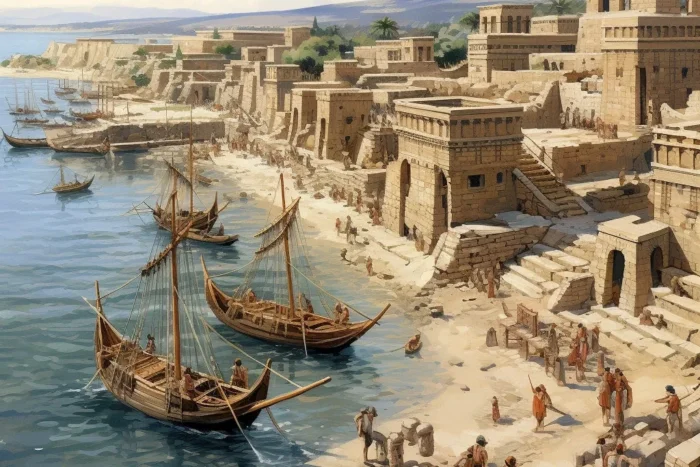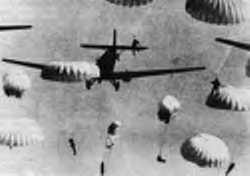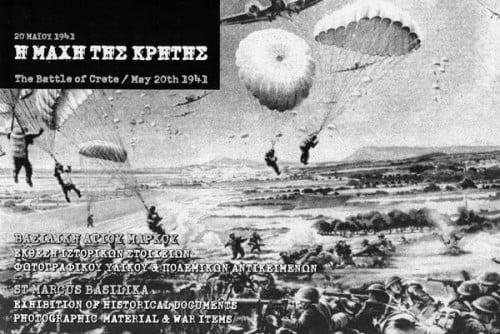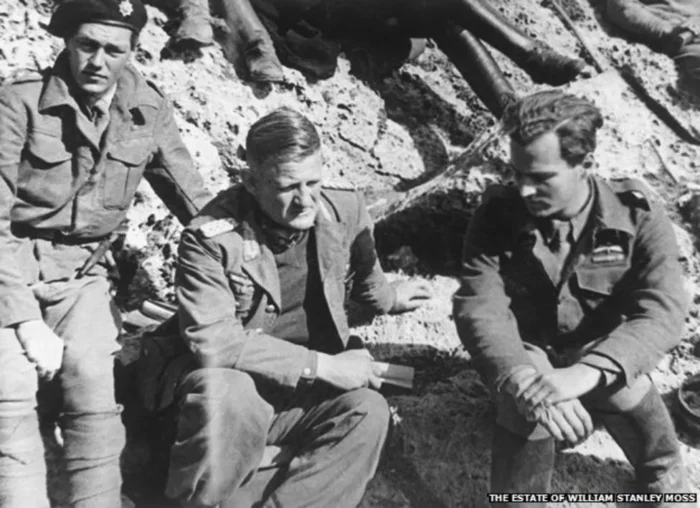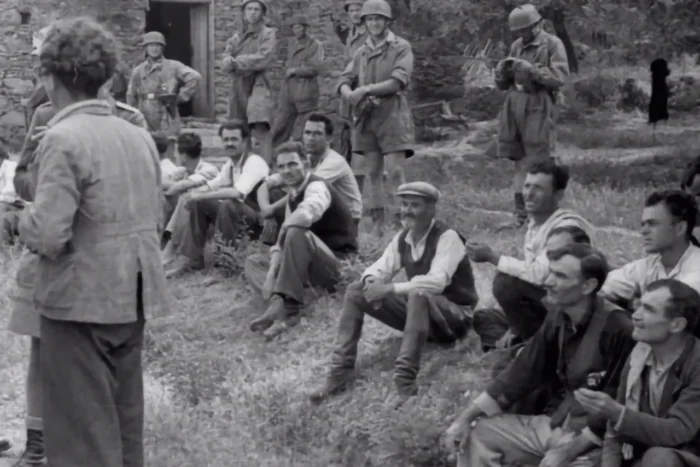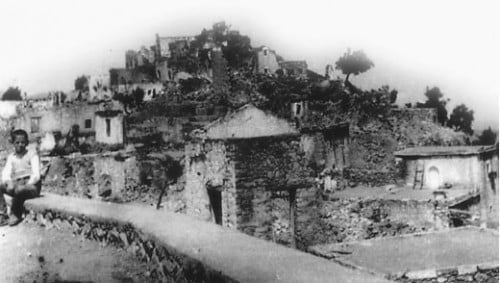Part 2: Union of Crete with Greece
Prince George in Crete and the early years of the autonomy period
The Prince arrived at Souda Bay aboard the Russian battleship Nicolaos I, escorted by the battleships of the other Great Powers. The welcoming by the enthusiastic crowds was unprecedented.
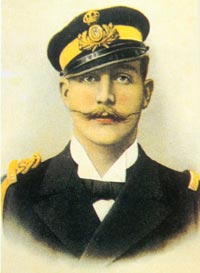
The admirals of the four Great Powers were also there to welcome him and the chairman of the Council of the Commanders of the forces, the French admiral Pottiers, escorted him to Chania where they first attended a thanks giving mass and then moved on to the government house where the admiral handed to him officially the control of the island. The new Cretan flag was raised and the event was saluted by canon fire from the naval ships anchored outside the harbour.
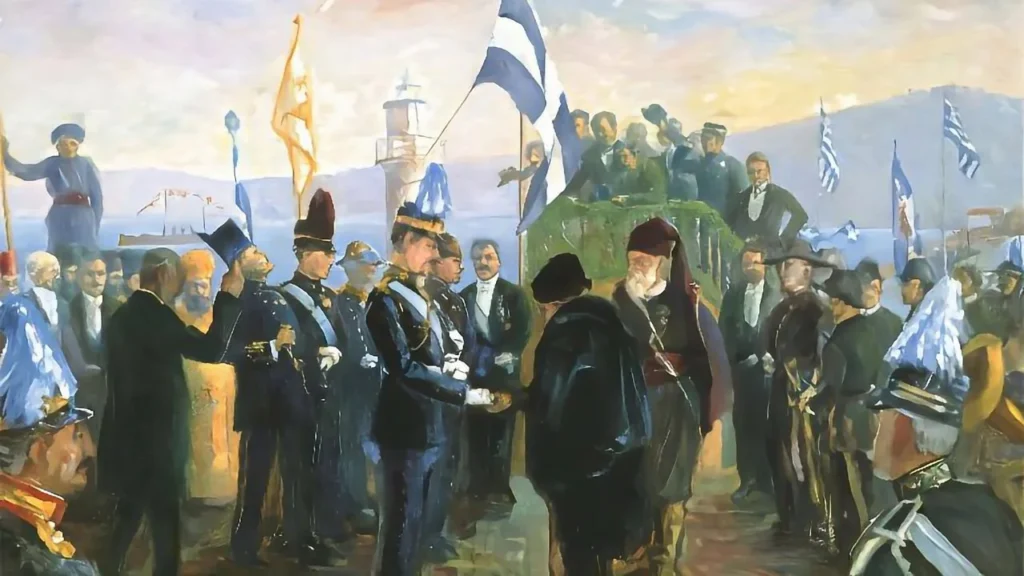
In a short period of time the Prince appointed a committee consisting of 12 Christian and 4 Muslim leaders, under the chairmanship of Ioannis Sfakianakis, to draft a new constitution for the island that was to be submitted to the Cretan assembly for approval. Elections were also called for 24 January 1899 during which a new Cretan Assembly was elected consisting of 138 Christian and 50 Muslim Cretans.
The Assembly sat for its first session on 8 February 1899 and approved the new constitution, which after being ratified by the High Commissioner and the Great Powers came into effect on 16 April 1899. On 27 April the High Commissioner appointed the first government that consisted of five ministers. They were:
- Eleftherios Venizelos as minister of Justice
- Manousos Koundouros as minister of foreign affairs
- Nikolaos Yamalakis minister of public education and religion
- Constantinos Foumis as minister of economic affairs
- Hussein Yenitsarakis as minister of public order.
The previous chairman of the interim governing committee chose not to participate having had a disagreement with the High Commissioner on the proposed format of the government.
The new government immediately started addressing the many tasks on hand. By 18 May Venizelos submitted the proposed new legal framework for the island and other initiatives were introduced, including a new currency, the formation of a central bank, public health and education initiatives as well as the formation of a new gendarmerie. The Prince on his own initiative went visiting Moscow, London, Paris and Rome trying to convince the Great Powers to push for the union of Crete with Greece, but all the four were unwilling to move away from the status quo.
Venizelos had different views on how union could be achieved, favouring a gradual and steady move towards that goal, and the differences between the two men soon became public knowledge. The conflict between the two became that big that the Prince eventually dismissed Venizelos on 18 March 1901(after refusing to accept Venizelos’ resignation which was submitted to him twice).
Venizelos formed an opposition party that remained very critical of the way the High Commissioner was interfering in the process of government. The Prince, upset by the continuing criticism by the Venizelos camp in both the Cretan and Greek press, became more authoritarian, banning the freedom of the press and harassing and arresting leading members of the opposition. The island had reached an other crisis point.
The Therisos uprising
On 26 February 1905 the opposition members issued a declaration demanding change to the Cretan constitution to free the island of authoritarianism and to pursue the objective of union with Greece, with an interim step the attainment of full independence. They stated also that in pursuing these objectives they were prepared to resort even to an armed uprising. A few days later on 10 March 1905 the opposition members, under the leadership of Eleftherios Venizelos, Konstantinos Foumis and Konstantinos Manos, gathered at Theriso, on the north foothills of the Lefka Ori – White Mountains together with an armed force of about one thousand men where they declared the commencement of an armed uprising in pursuit of union with Greece and raised the Greek flag. The rebellion spread very quickly throughout the island but the gendarmerie remained loyal to the Prince. The Great Powers showed restrain and were not prepared to interfere at that stage with the exception of the Russians who in support of the Prince commenced bombarding some of the rebel positions.
The Prince issued a 36 hour deadline for the rebels to lay down their arms and when that passed he declared martial law, with the permission of the Great Powers. He called for a meeting with the diplomatic representatives of the Great Powers and asked them to urgently take all necessary measures to put down the uprising. They in turn send a message to the rebels to lay down their arms, otherwise they were prepared to use their armed forces to put an end to the uprising. In response to this threat, more representatives from the Assembly in Chania went to Theriso to join the rebel government. In the meanwhile, Venizelos formed a caretaker government, organised government departments, issued bonds to raise funds, issued postage stamps and published a new newspaper, the Theriso.
The Great Powers at that stage were unwilling to enter into an armed conflict with the rebels and the Prince had no other means of taking on the rebels other than the 1,000 strong gendarmerie that was clearly insufficient for any action. The representatives of the Great Powers, seeing the lack of public support for the Prince decided to pursue a diplomatic solution and went to Mournies, just south of Chania, to meet the leadership of the caretaker rebel government. Negotiations continued on and off for months, with a final agreement for the end of the uprising being reached on 15 November 1906. This was going to be only a first step to a protracted series of negotiations between Venzelos’ opposition party and the foreign powers that were being handled on behalf of all the four powers by Sir Edward Law. His final recommendations were for a restructure of the gendarmerie and the formation of a new militia, both to come under the control of officers seconded from the Greek army; the departure of all foreign troops after law and order had been restored; provision of additional foreign loans; and a review of the Cretan constitution. Finally the Great Powers conceded to the King of Hellenes, George I the right to appoint the High Commissioner, subject to the agreement of the Great Powers.
This decision was made public on 14 September 1906 and a few days later the King announced the resignation of Prince George and the appointed Alexander Zaimis as the new High Commissioner, a well experienced and respected Greek political figure, having served previously as Prime Minister of Greece. Soon a new government was formed, a new constitution was passed by the Cretan Assembly, a new civil guard was established and by July 1907 large parts of the foreign power troops had departed from the island. The rest were to leave the island over the following twelve months after receiving guarantees for the safety of the Muslim population.
Enosis – Union with Greece
From the middle of 1908 certain events started unfolding that were to have a significant impact on the situation in Crete. Firstly the Turkish opposition movement, known as the “Young Turks” won power in July that year. On 5 October the Bulgarians taking advantage of the confused situation in Turkey they proclaimed their full independence annexing at the same time the eastern part of Macedonia. Next day the Austro-Hungarian Empire unilaterally annexed Bosnia and Herzegovina. The outrage about those events in both Athens and Crete was unprecedented, with public demonstrations condemning those actions and demanding immediate union of Crete with Greece.
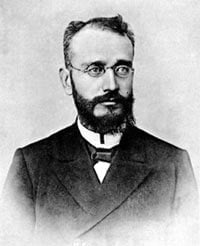
In Crete events moved very fast, with public meetings passing resolutions declaring the immediate annexation of Crete to Greece. On 6 October the Cretan Assembly passed a resolution forming an interim government to govern the island in the name of the king of the Hellenes, under the laws of the Greek state, until such time as the king of the Hellenes was ready to assume control of the island himself. The Cretan flag was lowered and in its place the blue and white flag of Greece was to be hoisted at the fort of Firka in Chania. The Greek government, although in full support of the moves in Crete, refrained from officially recognising the action of the Cretan Assembly, as it firstly wanted the full support of the Great Powers.
The Great Powers appeared to be accepting the developments in Crete but the Young Turks were demanding that the Greek government disavow the Cretan moves. The Great Powers were not prepared to aggravate the delicate diplomatic situation with the new government of the Young Turks and following insistent complaints from the Turks they demanded from the Cretan government that the Greek flag be lowered from the fort of Firka. Finally, when they saw that there was no intention by the Cretan government to obey to this instruction, they landed a military detachment at Chania and cut down the flagpole with the Greek flag.
The situation remained unresolved for a while. The Greek government was overthrown by a coup d’etat by a group of young military officers that had formed a “Military League” and who had forced the Greek Prime Minister to resign. Recognising that they lacked political expertise they invited Venizelos to join them as their political advisor. Venizelos being ready to join the Greek political scene accepted the invitation and joined them in January 1910. At the next elections in September he was elected to the Greek Assembly and by October 1910 he was the new Prime Minister of Greece. In the meanwhile Crete was going through a number of changes with its interim governments while at the same time Greece was unwilling to proceed to recognise the annexation of Crete, as it was trying to avoid any open conflict with either the Great Powers or Turkey. Venizelos’ refusal to accept any participation of Cretan representatives in the Greek Assembly led to an other uprising in Crete in January 1912
The start of the first Balkan War against Turkey in October 1912 was the catalyst to this difficult situation. The Greek Assembly immediately invited the deputies of the Cretan Assembly to join the Greek Assembly, as a first step towards full annexation. The defeat of Turkey and the Treaty of London on 30 May 1913 provided amongst others for Turkey to relinquish her title to Crete. In a separate treaty between Turkey and Greece, signed on 1 November 1913, the Sultan renounced all claims over Crete, thus ratifying the annexation of Crete to Greece. One month later, on 1 December 1913, the Greek flag was flying again on a new flagpole at the fort of Firka, in front of the King of the Hellenes Constantine, the Prime Minister of a united Greek nation, the Cretan Elefterios Venizelos and an ecstatic and tearful Cretan crowd. They had all been waiting for that moment for 267 years, 7 months and 7 days.
Article by George Dalidakis
Read more: Union of Crete with Greece – Part 1
© explorecrete.com All Rights Reserved. Reproduction or copying without permission is prohibited.

